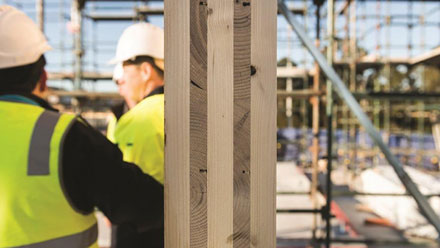
A material used in construction for centuries is making a comeback, as developers and builders take timber to new heights. Source: ABC News
On a site in Campbelltown, where four apartment towers are being built, almost the only noise you can hear is from another construction site nearby. A panel thuds into place. A drill whirs. A radio sings out over workers’ voices. Then, the screech of machinery from the other site.
Over the road, a conventional build is underway – mostly steel and concrete. But this one is an all-timber project – 101 residential units in towers up to eight storeys high, made completely from pine.
“It’s the perfect product for us to take our projects taller,” StrongBuild managing director Adam Strong said.
They are not using conventional wood, but manufactured, engineered materials collectively known as mass timber. Among them is cross-laminated timber (CLT) – layers of wood, glued together under high pressure with the grain of each perpendicular to the one before.
The end product is surprisingly strong and rigid, unlike raw timber, which will warp and weave over time.
“CLT, just by the very nature it’s assembled, means it’s quite dimensionally stable,” Arup engineer Craig Gibbons said.
That stability means mass timber components can be manufactured to the precise dimensions required by a project, and delivered to sites with a high degree of confidence they will assemble as planned.
It all works a bit like flat-packed furniture. The digital plans are sent to the manufacturer, where computer-controlled machines produce the timber elements to the exact dimensions required, right down where electrical wires will be chased down to light switches.
The panels are then put into shipping containers and delivered to the construction site, where builders slot them into place. With so much of the construction process taking place in an offsite factory, builders are less exposed to onsite risks such as accidents or weather delays – which helps make projects faster, cheaper and more predictable.
“There’s a big drive and push to any modular form of construction, any form of construction that can bring the advantages of offsite manufacturing,” Mr Strong said.
There is another major difference between a conventional building site and one where they are working in timber – far fewer workers.
Just four workmen are assembling the top floor of one of the Macarthur Gardens towers, with a few more working on lower floors. All these cost-saving advantages make a difference to developer BlueCHP Ltd, which specialises in affordable housing and plans to provide most of the apartments in this complex at 80% of market rent.
“The more modular your design is, the quicker the guys can build it, the quicker we can house people,” BlueCHP’s Marcelo Staimbeisser said.
The company had not envisaged the development as an all-timber construction, but when they saw the proposal, Mr Staimbeisser said there was such a difference in construction price, and significant time savings, that they took a punt on a building material they had not worked with before.
Now, Mr Staimbeisser said he hoped more developers would use it.
“The more timber projects out there, the cheaper it’s going to get in the long run,” Mr Staimbeisser said.
CLT is not a new building material – its growing popularity in Australia is the result of recent changes to building regulations, which are in turn the result of lengthy performance testing and industry consultation.
In May last year, Australia’s National Construction Code was changed so timber products could be used in buildings up to 25 metres high, without developers having to go through costly additional processes such as getting fire engineering approval each time.
Now, mid-rise buildings can be made of timber products, as long as sprinklers are installed in buildings over three storeys, and fire-resistant plasterboard covers all exposed wood. Another driving force behind timber is the growing interest in environmentally-friendly and sustainable products.
Advocates of mass timber are quick to point to the material’s green credentials, arguing it is a good insulator, which keeps down heating and cooling costs, and it is a store of carbon – unlike concrete and steel, which emit carbon during their production.
“One cubic metre of mass timber locks in about a tonne of carbon,” Mr Gibbon said.
But those representing conventional materials say they are not worried by the challenge posed by timber, and tout concrete as a natural product as well.
“It’s made out of certainly all natural resources — sand, stone, water and cement, which is manufactured from limestone, a very abundant product,” Cement, Concrete and Aggregates Australia CEO Ken Slattery said.
He conceded the production of cement emits carbon, but said the industry has worked to lower that by almost 30% over the past few decades and he believed it will come down further in the future.
As for insulation, Mr Slattery says well-designed concrete buildings can be highly energy-efficient, cutting down the amount of energy a building consumes over its entire life. But timber and conventional materials need not be at odds.
Mr Gibbon is working on a 20-storey wooden building in Amsterdam, and thinks that is about the limit for an all-timber structure.
Beyond that, he said timber will have to work together with concrete in what he calls a “happy hybrid”, where reinforced concrete and steel are used for the core, and timber for the walls and perimeter structure.
As demand increases for inner-city dwellings, he says he thinks more developers will turn to timber, for a quicker, less-disruptive option for high-rise structures.





